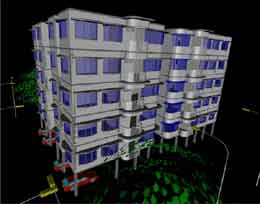Architecture |
5 Star Hotel |
Apartment

School Of Performing Arts
Thesis
MUSIC IN ARCHITECTURE? A design of a SPACE FOR MUSIC.
“I call architecture frozen music.” -Madame de Stael
“If architecture is frozen music, then music must be thawed architecture”- B. Hansen
|
INTRODUCTION: |
Music in a universal language of mankind. Almost everyone enjoys some form of music. Although techniques of presentation and styles may differ, the basic fabric of music is the same the world over and is universal. As a student of both music and architecture I would like to do a study connecting the two noble disciplines and design a space for music, tracing the link between both. The two arts, Music and Architecture are vastly separated from each other yet closely related. Music is in time alone, without any relation to space and architecture is in space alone, without any relation to time. Yet each is in a manner and to a degree not possible with any of the other arts convertible into the other by reason of the correspondence existing between intervals of time and intervals of space. Music is expressed by harmonious intervals of time, pitch, balance which has a close relation with the architectural design philosophies. It will be meaningful to create a “space” for music, which can reflect the principles and philosophies of music. |
"Architecture is frozen music." (Madame de Stael) There seems to have always been an aesthetic connection between architecture and Music/sound.Pythagoras claimed he could "hear" structured space and proportion, medieval court musicians filled open space with live music, and Gregorian singers likewise filled reverberant cathedral spaces with their chanting voices. Elevator music keeps people relaxed in a confined space and, currently, we are sonifying architectural constructs in cyberspace. It is apparent that throughout history humans have spent a great deal of energy mapping sound onto architectural spaces.Conversely, many examples exist of composers using number systems such as the golden rule and the Fibonacci series, both well-known for their applications in architecture. So my thesis will focus on integrating both Music and Architecture by its virtue of its concepts and principles by designing
|
“A Space for Music.” |
“Space for music”, a campus where all possible activities of music can take place. |
· A place to fulfill the dreams of those who take up music as their career. · Creating a good learning environment for the young ones to channelise themselves in a positive way · A place to feel music as well as architecture. · Using musical proportions in the design rather than various other proportioning systems. · Creating a” much felt need” environment for music and musicians. Each and every actions of human behavior starts with learning and observing right from his birth to death. Music is one of the finest art which can play with the human behavior irrespective of age,sex,place etc. |
the design…………….. |
The making of music is the interaction between the person, the instrument and the space, good musicians become united with their musical instruments and his space, and his musical expression will be direct. The place where music is made becomes an extension of the instrument as sound Interacts with its characteristics of the space. An individual, playing an instrument of his choice, will both practice and perform in a space. Thus the space will need to be opened and closed acoustically. The analogy is a music box, a well-crafted object which opens up to let out the music ! |
“space for music” will accommodate various “sound zones” |
|
Scope and design requirements.
Learning:
|
Observation /execution
Recreation:
Technical:
Residential:
|
Special Studies:
in the recording, re-recording theaters, concert halls radio station etc.
|
| Site Powered by Sujatha Selvin |